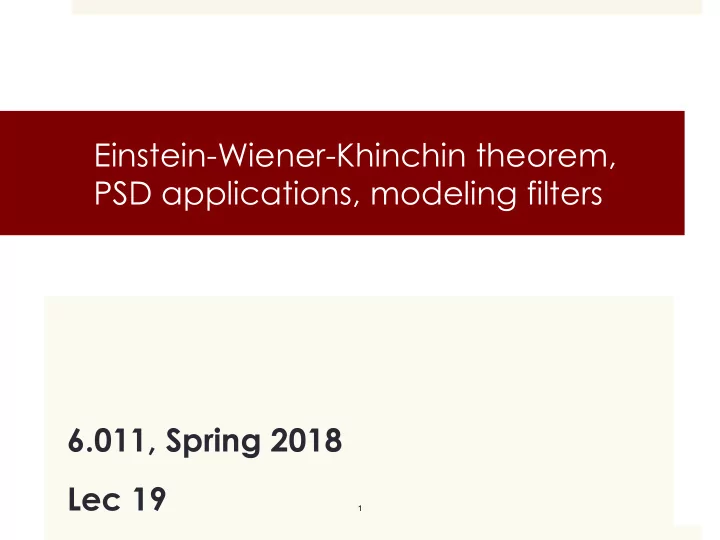

Einstein-Wiener-Khinchin theorem, PSD applications, modeling filters 6.011, Spring 2018 Lec 19 1
Periodograms (e.g., a unit-intensity “white” process) M = 1, T = 50 M = 1, T = 50 M = 1, T = 50 M = 1, T = 50 4 4 4 4 3 3 3 3 2 2 2 2 1 1 1 1 0 0 0 0 0 0.5 1 0 0.5 1 0 0.5 1 0 0.5 1 v /(2 p ) v /(2 p ) v /(2 p ) v /(2 p ) M = 4, T = 50 M = 4, T = 200 4 4 CT case: X T ( jω ) ↔ x ( t ) windowed to [ − T, T ] − 3 3 2 2 | X T ( j ω ) | 2 Periodogram = 1 1 2 T 0 0 0 0.2 0.4 0.6 0.8 1 0 0.2 0.4 0.6 0.8 1 v /(2 p ) v /(2 p ) M = 16, T = 50 M = 16, T = 200 4 DT case: X N ( e j Ω ) ↔ x [ n ] windowed to [ − N, N ] 4 − 3 3 2 2 | X N ( e j Ω ) | 2 Periodogram = 1 1 2 2 N + 1 0 0 v /(2 p ) v /(2 p )
Einstein-Wiener-Khinchin theorem 1 sin 2 ( ! T ) h | X T ( j ! ) | 2 i = S xx ( j ! ) ? E 2 T ⇡! 2 T sin 2 ( ! T ) Since lim � = δ ( ω ) , ⇡! 2 T T →∞ | X T ( j ! ) | 2 i 1 h lim = S xx ( j ! ) E T →∞ 2 T 3
Periodogram averaging (illustrating the Einstein-Wiener-Khinchin theorem) M = 1, T = 50 M = 1, T = 50 M = 1, T = 50 M = 1, T = 50 4 4 4 4 3 3 3 3 2 2 2 2 1 1 1 1 0 0 0 0 0 0.5 1 0 0.5 1 0 0.5 1 0 0.5 1 v /(2 p ) v /(2 p ) v /(2 p ) v /(2 p ) M = 4, T = 50 M = 4, T = 200 4 4 3 3 2 2 1 1 0 0 0 0.2 0.4 0.6 0.8 1 0 0.2 0.4 0.6 0.8 1 v /(2 p ) v /(2 p ) M 16, T 50 M 16, T 200 4 4 3 3 2 2 4 1 1 0 0 0 0.2 0.4 0.6 0.8 1 0 0.2 0.4 0.6 0.8 1 v /(2 p ) v /(2 p )
Periodogram averaging (illustrating the Einstein-Wiener-Khinchin theorem) M = 1, T = 50 M = 1, T = 50 M = 1, T = 50 M = 1, T = 50 4 4 4 4 3 3 3 3 2 2 2 2 1 1 1 1 0 0 0 0 0 0.5 1 0 0.5 1 0 0.5 1 0 0.5 1 v /(2 p ) v /(2 p ) v /(2 p ) v /(2 p ) M = 4, T = 50 M = 4, T = 200 4 4 3 3 2 2 1 1 0 0 0 0.2 0.4 0.6 0.8 1 0 0.2 0.4 0.6 0.8 1 v /(2 p ) v /(2 p ) M = 16, T = 50 M = 16, T = 200 4 4 3 3 2 2 1 1 5 0 0 0 0.2 0.4 0.6 0.8 1 0 0.2 0.4 0.6 0.8 1 v /(2 p ) v /(2 p )
Respiratory model cf. Khoo’s 6 textbook for N=1
Heart rate variability ECG signal 1.2 1 0.8 ECG amplitude (mV) 0.6 0.4 (a) 0.2 0 − 0.2 − 0.4 − 0.6 − 0.8 54 56 58 60 62 64 66 Time (sec) Instantaneous HR signal 1.3 x ( t ) (beats/sec) 1.25 (b) 1.2 1.15 1.1 45 50 55 60 65 70 75 80 Time (sec) Power spectrum 90 80 70 60 xx ( e ) j Æ 50 (c) 40 D 30 20 7 10 0 − 1 − 0.8 − 0.6 − 0.4 − 0.2 0 0.2 0.4 0.6 0.8 1 Frequency (Hz)
Modeling filters e.g., generate sample functions of WSS y [ · ] that has specified µ y σ − δ 2 ( ρδ [ m − 1] + δ [ m ] + ρδ [ m + 1]) and C yy [ m ] = σ y ↓ δ δ − Try h [ n ] = aδ [ n ] + bδ [ n − 1] driven by unit-intensity white noise x [ · ], | H ( e j Ω ) | 2 = D yy ( e j Ω ) H ( z ) = a + bz − 1 , More generally, H ( z ) A ( z ) for allpass A ( z ) , A ( z ) A ( z − 1 ) = 1 Need to add mean µ y to the output 8
MIT OpenCourseWare https://ocw.mit.edu 6.011 Signals, Systems and Inference Spring 201 8 For information about citing these materials or our Terms of Use, visit: https://ocw.mit.edu/terms. 9
Recommend
More recommend